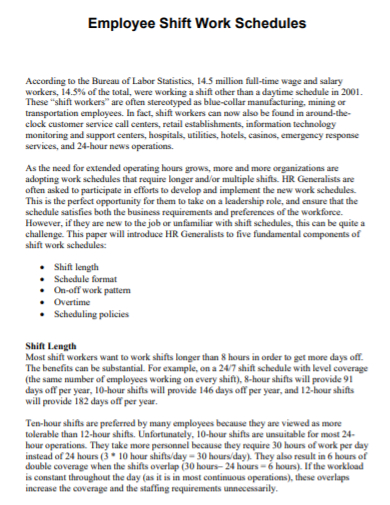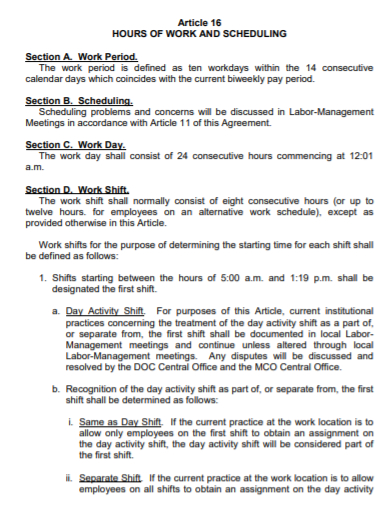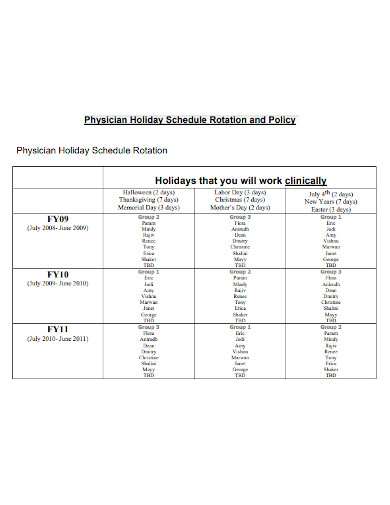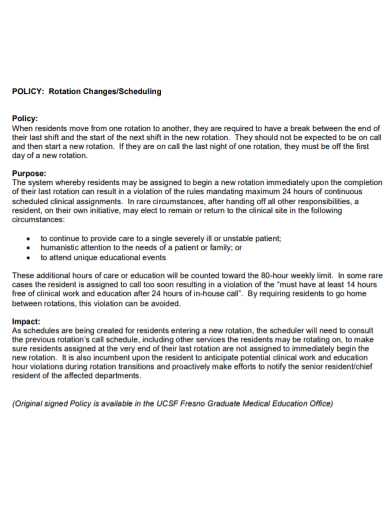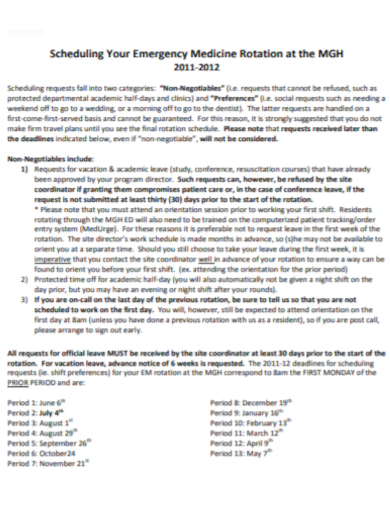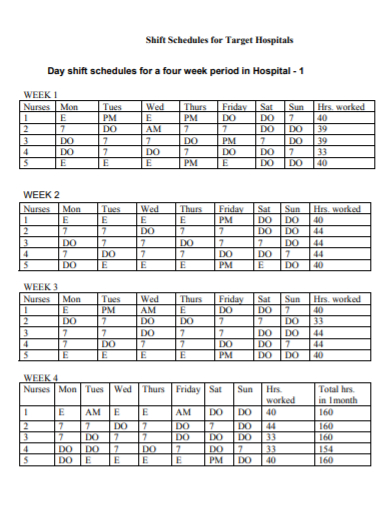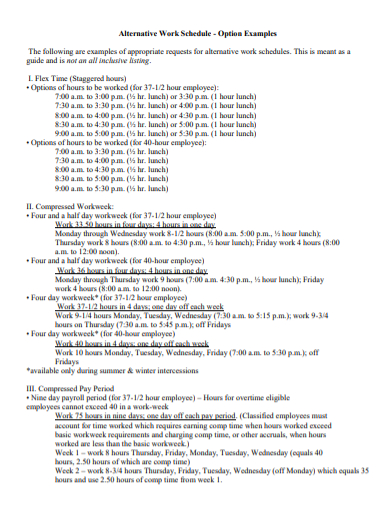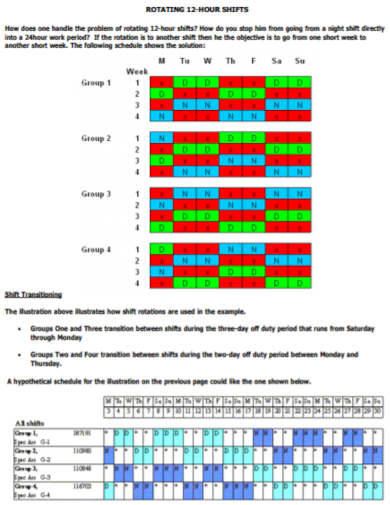10+ Rotating Shift Schedule Examples to Download
Working in jobs that require you to follow a rotating shift schedule can be challenging. Rotating shift schedules are used mainly by nurses, doctors, security guards and for some, teachers and agents whose clients are in a different time zone. Rotating schedules help in maintaining the right flow and flexibility for employees and for people who have to work at a specific time and day. For employers who are planning on setting a rotating shift schedule for their employees, here’s how. Here are some examples of rotating shift schedules you can download in Word, Docs, Sheets, Excel, PDF, and more.
10+ Rotating Shift Schedule Examples
1. Rotating Shift Schedule Template
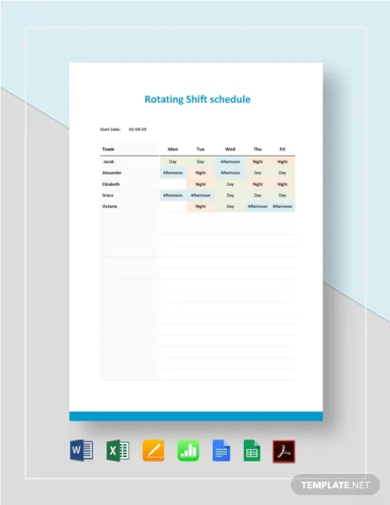
2. Rotation/Rotating Schedule Template
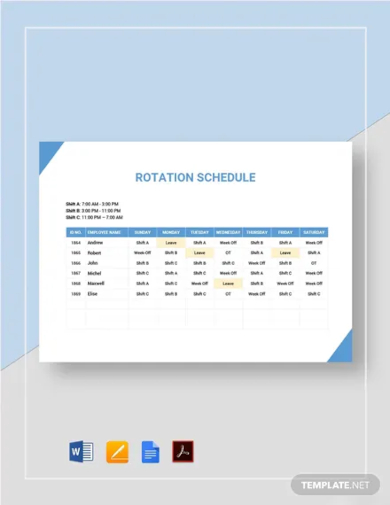
3. Employee Rotation Shift Work Schedule
4. Rotation Shift Hours Work Schedule
5. Holiday Rotation Shift Schedule
6. Rotating Classes Shift Schedule
7. Rotation Changes Policy Schedule
8. Emergency Rotating Shift Schedule
9. Rotating Day Shift Schedule
10. Rotating Alternative Work Shift Schedule
11. Rotating 12 Hours Shift Schedule
What Is a Rotating Shift Schedule?
Rotating shift schedules are plans made in order to rotate a fixed schedule and turn it into a flexible schedule. Rotating schedules are mainly used as a means to give employees time to settle in to new working hours and to get used to the rotating shift that should be expected from them. Companies and businesses do these in order for their employees to reach at least the required amount of hours to work. The most common of shift schedules are 8 hours, the other is a 12 to 14 hour shift. It’s important to be sure with your shift schedule and how to plot them.
How to Write a Rotating Shift Schedule
Company and business owners know it is important to set a schedule for employees to work and complete a 40 or 60 hours shift a week. In order for it to happen, a rotating shift schedule is made. The rotating schedule can be used for training schedule, daily schedule, weekly schedule, monthly schedule, or a yearly schedule. This all depends on you, the employer on how you plan for this. With that being said, to make a good rotating shift schedule that works for everyone, here are simple steps you need to follow to plot those schedules.
Step 1: Make a Solid Plan
To make a rotating shift schedule, start by making a solid plan. The solid plan should be based on the assessment you get from your employees and staff. Get to know each and every person in the company. Make a survey of which rotating shift schedule will benefit everyone. That way, you are able to find the right rotating shift schedule that can benefit the majority, if not everyone.
Step 2: Number of Working Days
Specify the number of working days for your employees. As there are 7 days to a week, you need to consider the 5 working days and 2 rest days. It is up to you, the employer, on how you are going to divide these 7 days to specific working days and working hours. Make sure that for that day, you give a specific work shift, whether it is an 8 hour shift or 12 hour shift.
Step 3: Set the Rotating Shift Schedule
Set a final output of the rotating shift schedule. This means you have settled on a rotating schedule that works for all your staff and employees. This also means you have decided on what hour shift you are setting for the rotating shift schedule and have added the two rest days that are required to all employees and staff. Make sure the rotating shift schedule benefits you, the company and your employees.
Step 4: Set into Motion
The last step is to set your schedule into motion. Prepare your employees. Make sure you give them an adjustment period for a smooth transition. It will also reap better results when the adjustment period and smooth transitioning is discussed and applied. Once it is done, you can expect employees to follow the shift schedule they are assigned.
FAQs
What is a rotating shift schedule?
Rotating shift schedules are plans made in order to rotate a fixed schedule and turn it into a flexible schedule. They range from the common 8 hours shift a day or 40 hours shift a week, to 12 hours shift a day or 60 hours a week shift.
Why do you need a rotating shift schedule?
Companies and businesses do these in order for their employees to reach at least the required amount of hours to work.
What are the two types of schedules?
The two types of schedules are 8 hours a day schedule or 40 hours a week schedule and 12 hours a day shift schedule or 60 hours a week schedule.
Employees who opt for a 40 hour shift know they need to stick to the schedule. Stick to a staff schedule that works. As an employer, it is your job to make sure rotating shifts can work for everyone. If you are new to making a rotating shift schedule, you can check out blank schedules to start making rotating schedules for employees. Don’t forget to check sample schedules, and work schedule examples for more.



